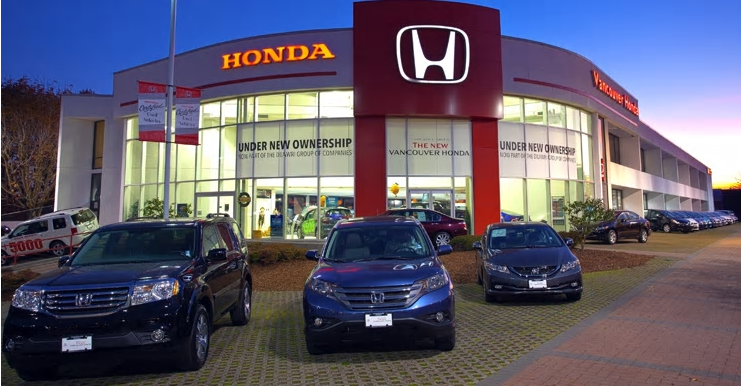Honda Achieves 100-Million Global Automobile Production Milestone
August 02 2019, Vancouver Honda

Canadian CR-V Production Contributes to the Impressive Tally
Considering that many of today's largest automakers are more than a century old, it's amazing to contemplate everything Honda has achieved within the car industry in just 53 years. In fact, on December 22, 2016, Honda Motor Co., Ltd. announced that it had surpassed the 100-million automobile production milestone. "Thanks to the support from our customers around the world," said Takahiro Hachigo, President, Chief Executive Officer and Representative Director of Honda Motor Co., Ltd. "Honda was able to deliver 100 million automobiles. The passion of our company founder who wanted to help people in their daily lives and pursue the joy of driving has been inherited by Honda associates as the original starting point of Honda automobile manufacturing. Striving to meet the next 100 million customers, Honda will continue delivering increasingly attractive products."
Honda first began assembling automobiles at its Saitama Factory in 1963, its initial mass-produced model being the tiny T360 mini-truck, the year after made slightly larger and renamed T500 (1964-1967). During that first year of automotive production Honda went from commercial success to building the pretty little S500 roadster (1963-1964), a convertible sports car built in the company's Hamamatsu Factory, within the Shizuoka Prefecture. The following year, 1964, with its sights set on full-scale automobile production the Japanese brand combined all of its motorcycle production experience and technologies, along with its then recently developed auto production know-how, within the Sayama Factory in Sayama City, Saitama Prefecture, this being Honda's first facility purely dedicated to automobile production. The first car produced at Sayama was the more powerful S600 sports car (1964-1966) in both roadster and coupe body styles, while in 1967 the front-engine, front-wheel drive, two-door, two-passenger, two-box N360 kei car (1967-1972) was added to the line. It was followed by the similarly sized Life (1971-1974) and first-generation N600 or Civic (1972-1979) as we've come to know it, and the rest, as they say, is history.
Over the past five decades Honda has expanded its product lineup to global proportions, while growing its model lineup to include Canadian bestsellers like the compact Civic Sedan and Coupe, now enhanced by a third Hatchback body style for 2017; the entirely new for 2017 CR-V compact SUV; the ever-popular mid-size Accord Sedan and Coupe; the advanced Pilot mid-size SUV with its state-of-the-art nine-speed automatic transmission; the all-new Ridgeline pickup truck that boasts a handy lockable trunk under its cargo bed; the premium-like Odyssey minivan that can even be had with a built-in vacuum; as well as the brilliantly designed Fit subcompact hatchback and HR-V subcompact SUV, with their innovative rear Magic Seats. Some of these models are built in North America, the Civic Sedan and Coupe plus the CR-V produced at Honda Canada's Alliston, Ontario plant, the Civic also produced in Greensburg, Indiana (the new Civic Hatchback exclusively hails from Swindon, England), whereas the Accord was the first Japanese four-passenger car made in America when it began production in 1982 at American Honda's Marysville, Ohio facility, not to mention the first vehicle produced by Honda's own subsidiary outside of Japan. The Odyssey, Pilot and Ridgeline were all previously built at the Alliston, Ontario plant, but are now produced in Lincoln, Alabama. Of note, in 2013 Honda became the first Japanese automaker to achieve net exporter status from the United States, exporting 108,705 Honda and Acura models to international markets, while importing only 88,357 from Japan.
Of course, Honda creates many more regional models that satisfy the needs and tastes of varying markets, all of which have added up to the milestone 100-millionth production number. Today the Japanese automaker also assembles vehicles throughout Asia, including China and India, in Europe, and in South America, the result being 34 automobile production facilities in 18 countries and territories. To be clear, the 100-million unit mark does not include the hundreds of millions of motorcycles Honda began producing as far back as 1946, or the brand's many powersport products. Factoring in these non-automobiles, Honda's worldwide overall production number swells to more than 560 million.
The company founder that Hachigo-san speaks of in his comments above is Soichiro Honda, who initially made his mark as a piston ring supplier to Toyota Corp. via his company Tōkai Seiki (Eastern Sea Precision Machine Company). The remnants of this Tōkai Seiki (one factory was bombed during WWII, and the other collapsed during the Mikawa earthquake just as the war was about to end in January, 1945) were later sold to Toyota with the proceeds invested in the Honda Technical Research Institute in 1946. Honda began producing motorized bicycles soon after. Honda has been the world's largest motorcycle manufacturer since 1959, while it became the second-largest Japanese automobile manufacturer in 2001. Honda is also the world's largest manufacturer of internal combustion engines (ICE) measured by volume, building more than 14 million ICE's per year.
On that note, along with its core automobile and motorcycle product lines Honda also produces powersport products such as all-terrain vehicles (ATVs) and personal watercraft, marine engines, tractors, garden equipment (push and ride-on lawn mowers, tillers, etc.), power generators, and other products. Honda is even involved in the aircraft business, having established GE Honda Aero Engines in 2004 and beginning production of its HA-420 HondaJet in 2012. As for the future, who knows? But Honda has had its hand in artificial intelligence (AI) and robotics research since 1986, making news headlines all over the world in 2000 when its ASIMO robot was revealed.


